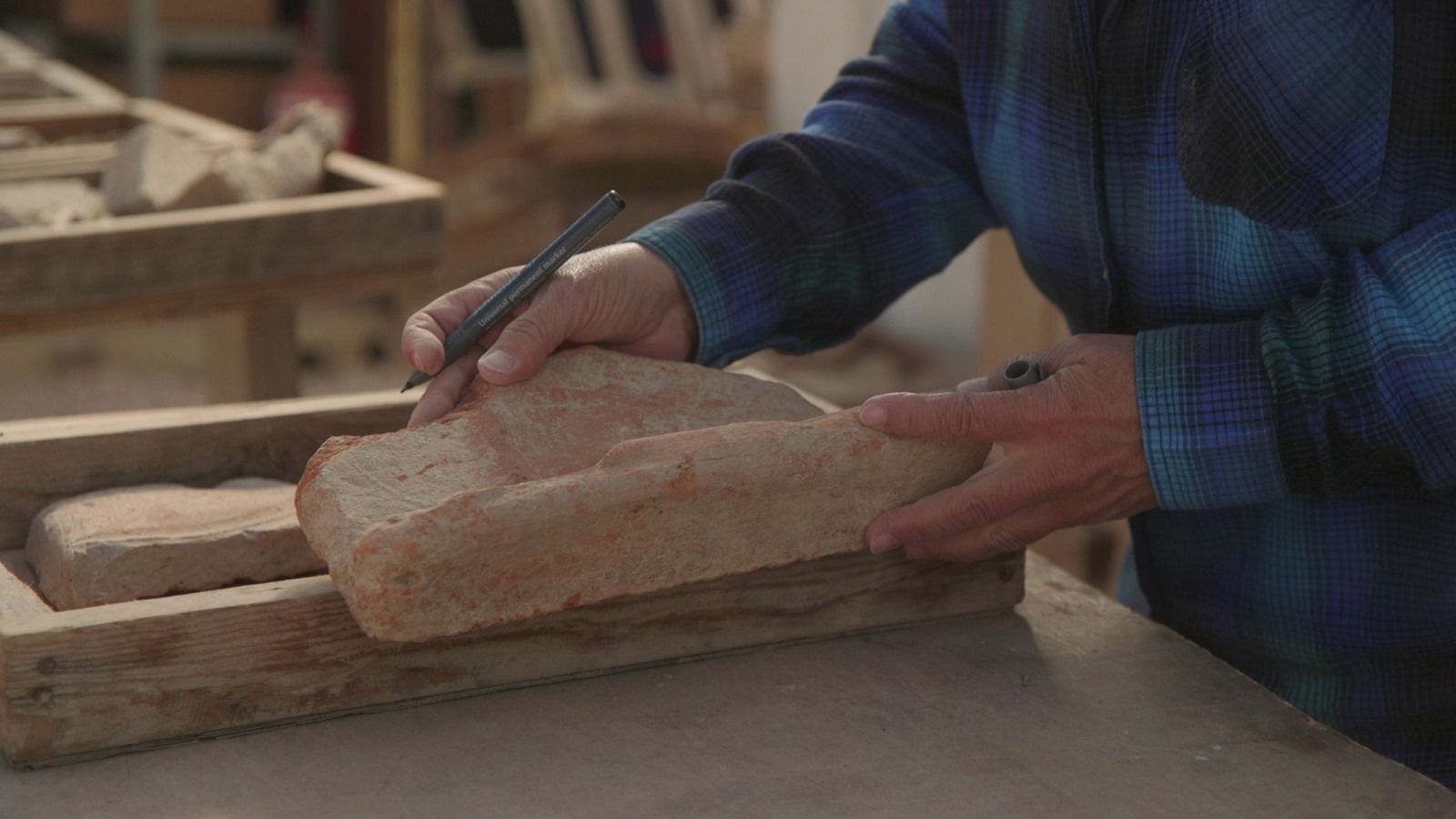A Roman legion camp excavated at the foot of Tel Megiddo

In a recent excavation led by the Israel Antiquities Authority at Legio, near the ancient Jewish village Kfar Othnay (in Greek: Capercotnai) at the foot of Tel Megiddo, architectural remains of a 1,800-year-old Roman VIth 'Ferrata' (which means "Iron") Legion camp have been uncovered.
Throughout the excavation, significant building and architectural features of the Via Pretoria, which is the main road of the camp, were unearthed alongside a semi-circular-shaped podium and stone-paved areas, which constituted components of an imposing, impressive public structure. This Roman legionary base of the VIth Legion stands as the sole example of such magnitude discovered and revealed in Israel.
Dr. Yotam Tepper and Barak Tzin directed the excavation, which was funded by the Netivei Israel National Infrastructure Company as part of the massive infrastructure project to upgrade Road 66 from the Megiddo Junction to the Hatishbi Junction in Yoqn‘eam.
This site area of Legio is well-known for his past discoveries: Among them is the famous prayer hall, one of the very first Christian Roman worshiping places in history, that was discovered in the Megiddo Prison compound near the current excavation of the camp. One of the mosaics discovered on the floor contained several inscriptions, including one that commemorates another God-loving woman who dedicated a prayer table “in the memory of the Lord, Jesus Christos.”
According to Dr. Tepper, who is leading the excavation of the military base on behalf of the Israel Antiquities Authority (IAA), the discovery of the major camp was not made inadvertently, and it is only a continuation of past excavation and research.
Six seasons of archaeological excavations and many surveys have been made during the last decades in partnership with Dr. Tepper, Dr. Matthew J. Adams, the Jezreel Valley research project, and carried out on behalf of the Albright Institute of Archaeology at Jerusalem. During these sessions, the upper part of the “Principia” (which is the commanders’ courtyard) was excavated on the southwest of Road No. 66. On the other hand, the IAA excavation of the military base today is located further north alongside the same road.
Past surveys using ground penetrating radar technology noticed the entire camp and all the relevant annex parts of it were situated below the agricultural fields of the nearby Kibbutz Megiddo. In archaeology research, site identification can be done sometimes be done with regular surveys of collecting ground topsoil artifacts or through aerial view research localizing anomalies, such as buried walls and architectonic lines in the ground.
“The Roman Legion camp at Legio was the permanent military base for over 5,000 Roman soldiers for more than 180 years, from 117–120 to about 300 CE,” explained Tepper, adding: “Two main roads intersected at the center of the 550 m long and 350 m wide camp, and its headquarters were erected here. It was from this base point that all the distances along the Roman Imperial roads to the main cities in the north of the country were measured and marked with milestones. The ancient building remains were not preserved to a height, as most of the building stones were removed over the years for reuse in building projects carried out during the Byzantine and Early Islamic periods.”

Dr. Tepper added that this project and its discovery are unique for the scientific research and our understanding of ancient Roman camps in the ancient Middle East since only temporary siege camps (such as the Masada siege system) or small auxiliary camps have been excavated in Israel till today. The camp of Legio is unique in that it belongs to an entire legion based in the area, and it is available for archaeological digging. Historical records and some archaeological hints have been mentioning and proving the existence of a camp at Jerusalem for another legion: The Legion X called “Fretensis.”
However, no actual exact localization of the site is known to this day, although there are several scholarly opinions about it. This legion stayed at Jerusalem for a very long time and moved probably to Aila (modern Eilat or Aqaba) around the year 300 A.D., and is recorded as still camping there in the 390s A.D. This legion is known for its principal role in the Actium naval battle of 31 B.C., the Fall of Jerusalem in the year 70 A.D., and the destruction of the Temple.
In the excavation at Legio, architectural elements, coins, parts of weapons, pottery sherds, and glass fragments were uncovered, but the most predominant finds are the roof tiles that have been found in extremely large quantities. This pattern of roof tiles found in the excavations, with a legion stamp on it, is also observed at Jerusalem: proof of a Legion camp situated in the vicinity.
“The roof tiles, some of which were stamped with the VIth Legion stamps, were used for various purposes, for roofing buildings, paving floors, and coating walls. The technology and know-how, the building techniques, and the weapons that the Legion brought with it from the home country are unique to the Roman army, reflecting specific Roman Imperial military footprints,” said Dr. Tepper.

Director of the Israel Antiquities Authority (IAA) Eli Escusido stated: “The proximity of the Roman legionary base to the National Park of Megiddo, recognized as a World Heritage Site, and also to one of the earliest Christian prayer halls known in the world, discovered by the Israel Antiquities Authority within the Megiddo Prison compound, provide potential to enhance the tourist experience at this central location at the gateway into the Galilee."
"Thanks to the excavations and the concentration of well-preserved archaeological remains, the Israel Antiquities Authority, and the Ministry of Heritage, together with Netivei Israel National Infrastructure Company and the National Parks Authority will evaluate the conservation of the site and the future of the planned Road No. 66,” the IAA director added.

Aaron Goel-Angot is a Belgian-Israeli archaeologist with an expertise in antiquities identification. He is an enthusiastic numismatist and a licensed tour guide. He holds a BA degree in archaeology from the Institute of Archaeology at the Hebrew University of Jerusalem. He joined the ALL ISRAEL NEWS team as an Archaeology and Tourism correspondent. Aaron is married, father of three young children and lives in Jerusalem.












